South Savage Mountain, Garrett County
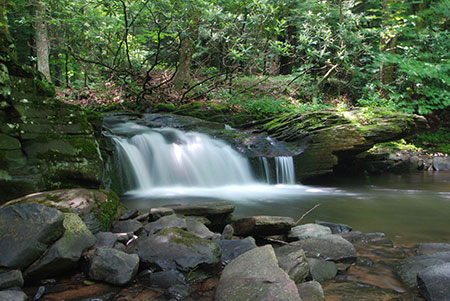
South Savage Mountain Natural Area is a large forested landscape nestled between the southern end of Big Savage Mountain and Savage River Reservoir. Much of the area contains very steep inclines. The intact forests are a mix of oaks, with chestnut and white oaks dominating on the upper slopes, and northern red and white oaks dominating on the lower portions. This forest supports an unusually diverse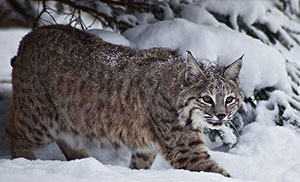
community of plants and animals, including invertebrates that thrive in the duff layer (decomposing organic matter) of the forest floor. The understory and canopy of the trees is utilized by forest interior nesting birds. Among these is the rare cerulean warbler (Dendroica caerulea), which specializes in foraging and nesting in the tallest trees. American black bears roam through the forest in search of acorns, berries and the occasional small animal. Rare bobcats (Lynx rufus) stalk silently through the thickets. Much of this area is underlain by acidic sandstones and shale, so the soils primarily support plant communities that prefer or require acidic conditions. However there are areas where less acidic conditions persist, particularly in a band near Savage River where a number of notable rare plant populations have been found. Among the very diverse herbaceous plant community in this area's understory is a population of the Endangered Porter's reedgrass (Calamagrostis porteri). Its occurrence here is the only documented population for the entire Allegheny Plateau within the state.
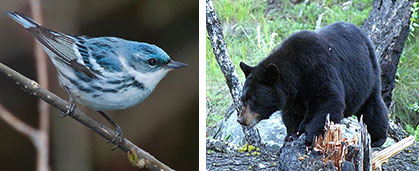
Even though the South Savage Mountain Natural Area does not typically include permanent streams, it does contain ephemeral streams, vernal pools, springs and seepage areas. These small water bodies provide habitat for a number of rare or uncommon invertebrates, as well as amphibians, and contribute to overall habitat diversity. Surface streams in this region generally are clean and cool, supporting notable populations of native aquatic species, including fish such as brook trout. South Savage Mountain Natural Area encompasses over 2,000 acres and provides habitat for more than a dozen rare plants and animals. It is contained within Savage River State Forest and is managed as a designated State Wildland.
Old Growth Forest
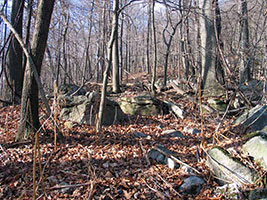 Nearly 800 acres of old growth forest have been identified in this Natural Area, which is one of the largest remaining documented areas in Maryland that meet the Department of Natural Resource's criteria for old growth. Some of these criteria include large trees with a high degree of structural diversity as well as dead trees still standing or decaying on the ground. Combined, these features provide key habitat for a variety of birds, especially warblers and woodpeckers, several plants and insects, and mammals such as the eastern red bat. Streams that course through old growth forests have large amounts of rough, woody debris that, in turn, create ideal habitat for many aquatic invertebrates and fish.
Nearly 800 acres of old growth forest have been identified in this Natural Area, which is one of the largest remaining documented areas in Maryland that meet the Department of Natural Resource's criteria for old growth. Some of these criteria include large trees with a high degree of structural diversity as well as dead trees still standing or decaying on the ground. Combined, these features provide key habitat for a variety of birds, especially warblers and woodpeckers, several plants and insects, and mammals such as the eastern red bat. Streams that course through old growth forests have large amounts of rough, woody debris that, in turn, create ideal habitat for many aquatic invertebrates and fish.
Tale of a Cottontail
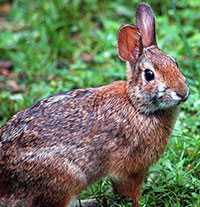 Closely resembling the familiar eastern cottontail, the rare Appalachian cottontail (Sylvilagus obscurus) can be distinguished by its smaller size, shorter ears, darker fur between the ears and along the back, and especially by differing skull features. Unlike the widespread and adaptable eastern cottontail, the Appalachian cottontail's range is restricted by its mountain habitat requirements of large tracts of contiguous forest with embedded semi-open areas containing dense thickets of mountain laurel or great rhododendron. The old growth forests within South Savage Mountain Natural Area provide just such a setting. No longer considered a game animal in Maryland, the Appalachian cottontail is currently listed as In Need of Conservation. Its greatest threat is the invasion by its cousin, the eastern cottontail, via roads and clearings that penetrate large forest tracts.
Closely resembling the familiar eastern cottontail, the rare Appalachian cottontail (Sylvilagus obscurus) can be distinguished by its smaller size, shorter ears, darker fur between the ears and along the back, and especially by differing skull features. Unlike the widespread and adaptable eastern cottontail, the Appalachian cottontail's range is restricted by its mountain habitat requirements of large tracts of contiguous forest with embedded semi-open areas containing dense thickets of mountain laurel or great rhododendron. The old growth forests within South Savage Mountain Natural Area provide just such a setting. No longer considered a game animal in Maryland, the Appalachian cottontail is currently listed as In Need of Conservation. Its greatest threat is the invasion by its cousin, the eastern cottontail, via roads and clearings that penetrate large forest tracts.

South Savage River Natural Area
Special Note: Savage River State Forest is used seasonally by hunters.
Directions
From Frederick: Take I-70 west to I-68 at Hancock. Continue on I-68 about 40 miles to Exit 42 on the west side of Cumberland. Follow US 220 (McMullen Highway SW) south about 18 miles to McCoole. Turn right onto MD 135 (Westernport Road SW) and proceed 5 miles to MD 36 in Westernport. Continue straight across and go 2 miles more to Bloomington. Turn left to stay on MD 135 (Bloomington Road), cross the Savage River bridge, and turn right in 0.1 mile onto Savage River Road. Continue about 4 miles to a parking area on the right.
Driving directions and aerial views open with Google Maps. For the aerial view button, if an aerial view does not open by default, click on the Satellite icon in the upper right corner and Google Maps will switch to an aerial view of the Natural Area.
